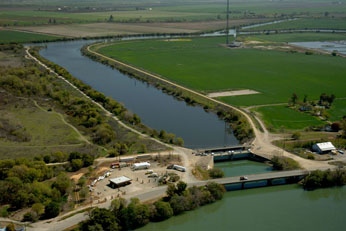State Water Project and Central Valley Project
 DWR photo.
DWR photo.
The California Department of Water Resources (DWR) and the U.S. Bureau of Reclamation (Reclamation) operate, maintain, and manage the State Water Project (SWP) and Central Valley Project (CVP) facilities, respectively. Both projects are water storage and delivery systems composed of reservoirs, aqueducts, power plants, and pumping plants. Their main purpose is to store water and distribute it to urban and agricultural water suppliers in Northern California, the San Francisco Bay Area, the San Joaquin Valley, the Central Coast, and Southern California.
For more information regarding the CVP/SWP operations, visit the Reclamation and DWR websites.
Compliance with the Federal and California Endangered Species Acts
In 2020, California Department of Fish and Wildlife (CDFW) issued DWR a California Endangered Species Act (CESA) incidental take permit (ITP) for the long-term operation of the SWP in the Sacramento-San Joaquin Delta for the protection of Delta smelt, longfin smelt, spring-run Chinook salmon, and winter-run Chinook salmon.
For more information on the SWP ITP, visit CDFW's Water and Watershed Conservation page.
The U.S. Fish and Wildlife Service (USFWS) Biological Opinion for the Reinitiation of Consultation on Long-Term Operations of the Central Valley Project and State Water Project and the National Marine Fisheries Service (NMFS) Biological Opinion on Long-Term Operations of the Central Valley Project and the State Water Project were issued on October 22, 2019. They include incidental take statements (ITS) for Delta smelt, winter-run Chinook salmon, spring-run Chinook salmon, green sturgeon, and steelhead. These biological opinions (BiOps) were formally adopted on February 19, 2020 when Reclamation signed the Record of Decision.
For more information regarding the biological opinions, visit the USFWS and NMFS websites.
CDFW's Role in Water Operations
CDFW’s Water Operations Program participates in multiple work teams that make real-time water operation decisions for the SWP and CVP. CDFW provides recommendations intended to minimize adverse effects on state and federally listed fish species and to ensure compliance with CESA requirements specified in the SWP ITP conditions. The following teams are required by the SWP ITP:
Smelt Monitoring Team
The Smelt Monitoring Team (SMT) consists of representatives from
CDFW, USFWS, DWR, Reclamation and State Water Resources Control Board
(SWRCB). The SMT considers survey data, salvage data, and other
pertinent biotic and abiotic factors to assess the risk of entrainment
to Delta smelt and longfin smelt from the operation of the SWP and CVP.
Based on the risk assessment, the SMT provides advice for real-time
management of operations to WOMT, consistent the USFWS BiOp and SWP ITP.